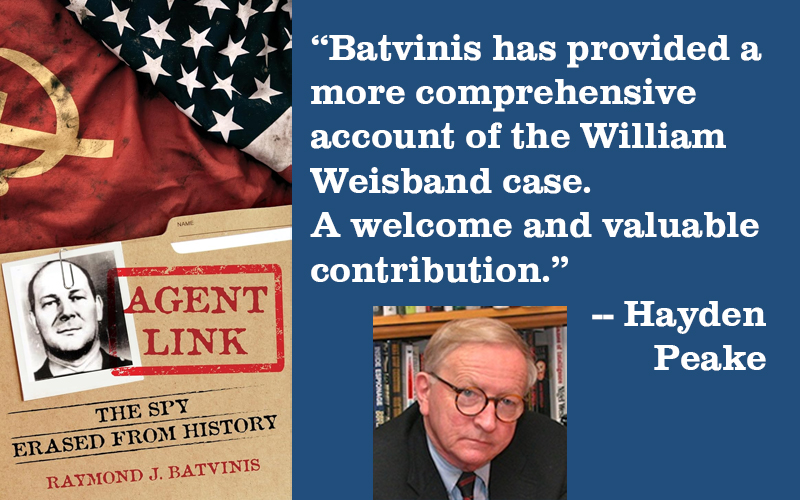
My book, “Agent Link” was reviewed by intelligence book historian Hayden Peake in the September 2024 issue of CIA’s Studies in Intelligence:
Sometime in 1934, William Weisband, a clerk working for the Waldorf Astoria Hotel in New York was recruited by the KGB and given the codename LINK. Fifteen years later another KGB agent he turned him in to the FBI.
Although his codename appeared in the VENONA traffic, he never spent a day in jail for his spying. Espionage historian and retired FBI special agent Raymond Batvinis tells this unusual counterintelligence story in Agent Link.
That Weisband was a KGB agent during World War II is not a revelation, but many details of his life and espionage operations have not been reported because his FBI, NSA, US Army, and KGB files were unavailable until recently. Some remain classified, but Batvinis acquired enough new material to provide a more thorough, although still incomplete, account of Weisman’s life.
The files say he was born Wolfe Weisband in Alexandria, Egypt, on August 28, 1908, although later in life he would say he was born in Russia. His parents had emigrated to the United States to escape persecution there.
In 1925, the family moved to New York City, where Wolfe soon became William. He would quickly become enamored of a libertine lifestyle in the city. Trying to support what became expensive habits, he took a series of clerical jobs in hotels.
Batvinis estimates that during his six-year stint at the Waldorf Astoria, he began to work for the KGB, but exactly when and under what circumstances remains classified (or lost) in Russian files. Although Moscow’s new agent had no technical expertise, Batvinis suggests he was just right for service as a courier. In any case, his immediate financial problems were solved.
Agent Link follows Weisband’s courier and later agent-handling career in the 1930s and early 1940s, when he moved to California and began running agents, including Jones Orin York, who would betray him to the FBI after the war.
Batvinis also describes Weisband’s military career, which began when he was drafted into the US Army on September 1, 1942. Mainly because of his linguistic skills, he was eventually commissioned, sent to signal school at Ft. Monmouth, New Jersey, and then served overseas, all the while still serving as a KGB agent.
Returning to the States in late 1944, he was assigned to Arlington Hall Station, where Army Signal Corps code-breaking was headquartered. It was there that he would do the most damage, translating what came to be called the VENONA messages and, of course, informing the KGB that its messages were being decoded.
Batvinis stresses that Weisband didn’t know to whom the traffic referred, since codenames were used. That revelation was provided by Kim Philby. Thus, Batvinis concludes, by 1949, “there was nothing that American code breakers were doing that Moscow didn’t know.” (253)
On February 2, 1948, after Meredith Gardner, the VENONA codebreaker, discovered that a KGB spy codenamed NEEDLE was Jones Orin York, Weisband’s days were numbered. Batvinis describes what happened after York identified LINK and why Weisban eventually served a year in jail for contempt of court.
Once free, he had periodic, troubled contacts with the FBI and NSA as he tried to support his family. He died on May 14, 1967, with his wife Mabel and their children at his side.
Agent Link features an unusual literary style that gives the reader a broad view, not only of Weisband, but of the many intelligence officers and agents with whom he had direct and indirect contact.
For example, in addressing the defection of GRU code clerk Igor Gouzenko, Batvinis provides a short biography of Gouzenko before addressing his impact on LINK. Likewise with Philby, Elizabeth Bentley, Anatoli Golitsyn, Alexander Feklisov, and many FBI special agents.
Batvinis has provided a more comprehensive account of the William Weisband case. A welcome and valuable contribution.
You must be logged in to post a comment.